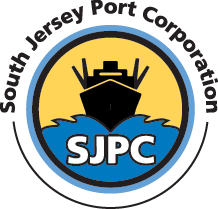The South Jersey Port Corporation (SJPC) and Holt Logistics Corporation have created a beneficial partnership that drives their mutual success and is a cornerstone to New Jersey’s efforts to be the epicenter of the $100 billion offshore wind energy industry.
“We succeed when our tenants, customers, and partners succeed,” explained Andy Saporito, the SJPC’s Executive Director and CEO. “We share the mission of fueling a robust economy for South Jersey and growing and supporting jobs throughout the region.”
Leo Holt, president of Holt Logistics Corporation agrees: “We’re job-providers… providers of family-sustaining jobs across our ecosystem of many different platforms that go beyond dockworkers, teamsters, and machinists.”
The partnership is a vital part of the supply chain supporting manufacturing, construction, and industrial jobs – as well as that of their suppliers and vendors, throughout New Jersey and the region stretching to the Mississippi River and the Great Lakes regions.
“It’s the virtuous byproduct of what we – Holt and South Jersey Ports – do,” added Holt.
As a stevedore operating company, warehousing, and ship operator headquartered in Gloucester City, New Jersey, the Holt family company has been a fierce maritime competitor along the Delaware River since 1926 and has built a worldwide reputation as a top origin to market logistics provider.
Today the once competitive relationship between SJPC and Holt has morphed into a partnership. Holt leases and operates two of SJPC’s most important assets: Pier 5 at Broadway Marine Terminal, the refrigerated fresh-fruit center of the port; and the newer Paulsboro Marine Terminal the keystone of the emerging offshore wind energy industry.
At Pier 5, Holt provides importers and exporters with a vertically integrated supply chain solution. There are three reefer buildings with more than 200,000 square feet of refrigerated warehouse space and 100 reefer plugs. Pier 5 has one berth with 1,135 linear feet at a depth of 35 feet. There is direct highway access to I-295 via I-676 and connections to Class 1 freight rail lines owned by NS, CSX, and Conrail.
SJPC invested $400 million to construct Paulsboro Marine Terminal, which Holt now operates. By building a terminal with heavy lifting load capacity, the port has the unique capacity to accommodate the huge and heavy monopiles for offshore wind farms while also accommodating much lighter general cargo as well as the steel slab imports for buildings, highways, cars, and appliances. This has positioned Southern New Jersey as a key import location for the steel industry and for the manufacturing, construction, support, and maintenance for the Atlantic coast wind energy industry.
The Paulsboro Marine Terminal is at a depth of 45 feet. It has three berths with 3,200 linear feet, two Liebherr mobile harbor cranes, trucks, lift equipment, reach stackers, and trailers. There is the ability to discharge or load heavy cargo direct to or from rail and the ability to load two trains simultaneously because there is a loop track and center loading track. For transportation, there is direct road access to Interstate 295 and on-dock rail that connects to Class I Freight Railroads: Norfolk Southern, CSX, and CP Rail. So far, with many new projects in the planning phase, Holt has invested nearly $15 million into the operation.
EEW, the German manufacturer of the massive steel monopiles is constructing a $250 million, six-building industrial complex at Paulsboro Marine Terminal to manufacture 100 monopiles a year for contracts it already has. Holt and its steel manufacturing client, NLMK, plan to compete to supply the 150,000 tons of rolled steel EEW will need each year to be fabricated into monopiles.
Even before Paulsboro was officially opened, Holt was unloading Russian steel at the terminal for NLMK Group’s steel plant in Farrell, Pennsylvania. In 2016, Holt moved 1.6 million tons of steel slabs through the port. In the following years, NLMK and other steel importers were hit with massive Federal tariffs on steel imports in an effort to boost domestic steel production. As a result, NLMK’s tonnage plummeted to one million tons annually as its steel plant, was starving for affordable steel slabs as domestic producers simply raised their prices. Then COVID recession hit shrinking demand and starving the supply chain. Holt responded by investing millions in employee safety protocols and preparing for the rebound.
Holt credited NLMK for its smart mitigation. It successfully reversed the tariffs by proving that it is an American manufacturer and diversified its supply chain for steel slabs to include Brazil and Mexico. It reworked its labor contracts that both benefitted its employees and freed up capital to finance a $200 million “Walk-in Beam Furnace” that will improve NLMK’s productivity and produce massive steel beams.
Now, the steel market can’t keep up with the demand as the global economy rebounds. “If you want to build a building, you can’t get the steel joists because Amazon has it bought for six to eight months out to build its fulfillment centers,” Holt observed.
The American supply chain needs more imported steel slabs to fuel the recovery and mitigate inflation. Holt anticipates its slab imports at Paulsboro will rebound past the previous high of 1.6 million tons annually to 2 million tons and more for the foreseeable future.



